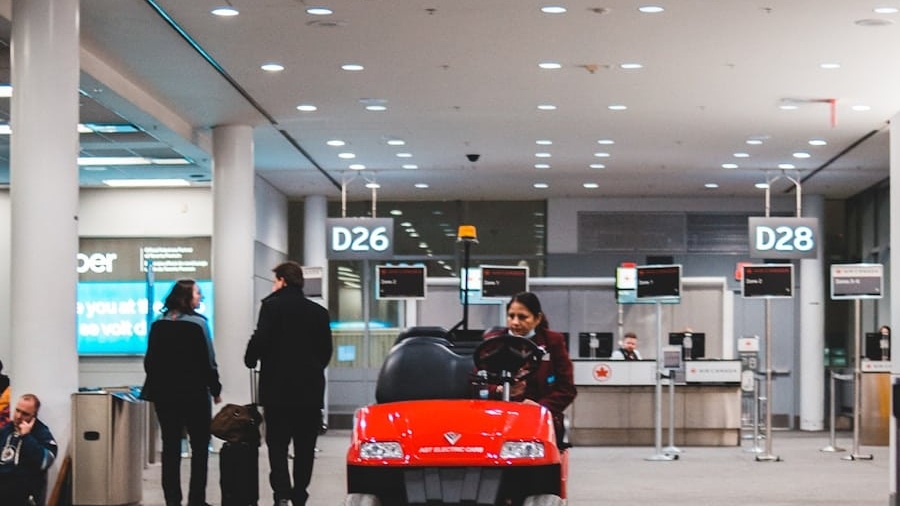The advent of mobile robots has revolutionized various sectors, and the airport and transport hub industry is no exception. As global travel continues to increase, the demand for efficient operations and enhanced customer experiences has never been more pressing. Mobile robots, equipped with advanced technologies such as artificial intelligence, machine learning, and sophisticated sensors, are being deployed to streamline processes, reduce human error, and improve overall service delivery.
These robots are not merely futuristic concepts; they are practical solutions that are already being integrated into the daily operations of airports and transport hubs around the world. Mobile robots in these environments serve a multitude of functions, from baggage handling to passenger assistance. Their ability to navigate complex environments autonomously allows them to perform tasks that were traditionally labor-intensive and time-consuming.
As airports and transport hubs strive to enhance operational efficiency while maintaining high safety standards, the integration of mobile robots presents a compelling opportunity. This article delves into the current applications, advantages, challenges, and future developments of mobile robots in these critical infrastructures.
Key Takeaways
- Mobile robots are increasingly being used in airport and transport hubs to improve efficiency and customer experience.
- Current applications of mobile robots in airport and transport hubs include baggage handling, cleaning, security, and passenger assistance.
- The advantages of mobile robots in airport and transport hubs include increased efficiency, cost savings, and improved safety and security.
- Challenges and limitations of mobile robots in airport and transport hubs include high initial costs, limited adaptability, and potential job displacement.
- Future developments and innovations in mobile robots for airport and transport hubs include advanced AI and machine learning capabilities, improved navigation and obstacle avoidance, and enhanced human-robot interaction.
Current Applications of Mobile Robots in Airport and Transport Hubs
Mobile robots are currently employed in various capacities within airports and transport hubs, showcasing their versatility and adaptability. One prominent application is in baggage handling systems. Automated baggage robots can transport luggage from check-in counters to aircraft or from arrival gates to baggage claim areas.
For instance, at airports like Changi in Singapore, autonomous baggage trolleys have been introduced to assist passengers in navigating the terminal while carrying their luggage. These robots not only alleviate the burden on human staff but also minimize the risk of lost or mishandled baggage. Another significant application is in passenger assistance.
Robots such as the “Pepper” robot have been deployed in several airports to provide information and guidance to travelers. These robots can interact with passengers in multiple languages, offering directions, flight information, and even local recommendations. In addition to enhancing customer service, these robots help reduce congestion at information desks, allowing human staff to focus on more complex inquiries that require personal interaction.
Furthermore, some airports are experimenting with mobile robots that can deliver food and beverages directly to passengers waiting at gates or lounges, thereby enhancing the overall travel experience.
Advantages of Mobile Robots in Airport and Transport Hubs
The integration of mobile robots into airport and transport hub operations offers numerous advantages that contribute to improved efficiency and service quality. One of the most significant benefits is the reduction in operational costs. By automating routine tasks such as baggage handling and passenger assistance, airports can decrease their reliance on human labor for these functions.
This not only leads to cost savings but also allows human staff to be redeployed to areas where their expertise is more valuable, such as customer service or emergency response. Moreover, mobile robots enhance operational efficiency by increasing the speed and accuracy of various processes. For example, autonomous baggage handling systems can operate continuously without breaks, leading to faster turnaround times for flights.
This efficiency is crucial in an industry where time is of the essence; even a few minutes saved in baggage handling can significantly impact flight schedules and overall airport operations. Additionally, the precision of robots reduces the likelihood of human error, which can lead to costly mistakes such as misrouted luggage or incorrect passenger information.
Challenges and Limitations of Mobile Robots in Airport and Transport Hubs
Despite their numerous advantages, the deployment of mobile robots in airports and transport hubs is not without challenges. One of the primary concerns is the complexity of airport environments. Airports are bustling with activity, featuring a diverse array of moving vehicles, pedestrians, and other obstacles that can complicate navigation for autonomous robots.
Ensuring that these robots can operate safely and efficiently in such dynamic settings requires sophisticated algorithms and robust sensor technologies. Another significant limitation is the initial investment required for implementing mobile robot systems. While the long-term savings may justify the costs, many airports face budget constraints that make it difficult to invest in advanced robotic technologies.
Additionally, there may be resistance from staff who fear job displacement due to automation. Addressing these concerns requires careful change management strategies that emphasize retraining and upskilling existing employees rather than outright replacement.
Future Developments and Innovations in Mobile Robots for Airport and Transport Hubs
The future of mobile robots in airports and transport hubs is poised for exciting developments driven by rapid advancements in technology. One area of innovation is the integration of artificial intelligence (AI) with machine learning capabilities. As these technologies evolve, mobile robots will become increasingly adept at learning from their environments and adapting their behaviors accordingly.
This could lead to more efficient navigation systems that allow robots to optimize their routes based on real-time data about passenger flow and operational demands.
With faster data transmission speeds and lower latency, robots will be able to communicate with each other and with central control systems in real-time.
This interconnectedness will facilitate coordinated operations among multiple robots, enhancing their ability to work together seamlessly in tasks such as baggage handling or passenger assistance.
Impact of Mobile Robots on Efficiency and Customer Experience in Airport and Transport Hubs
The impact of mobile robots on efficiency within airport and transport hubs is profound. By automating routine tasks, these robots free up human resources for more complex responsibilities that require emotional intelligence or critical thinking skills. For instance, while a robot handles luggage transport, human staff can focus on providing personalized assistance to passengers who may have special needs or inquiries about their travel plans.
From a customer experience perspective, mobile robots enhance the overall travel journey by providing timely information and assistance. Passengers often face stress during travel due to tight schedules or unfamiliar environments; having access to robotic assistance can alleviate some of this anxiety. For example, a robot providing real-time updates about flight delays or gate changes can help passengers navigate their journeys more smoothly.
Furthermore, the novelty of interacting with a robot can create a memorable experience that enhances customer satisfaction.
Regulatory and Safety Considerations for Mobile Robots in Airport and Transport Hubs
As mobile robots become more prevalent in airports and transport hubs, regulatory frameworks must evolve to address safety concerns associated with their operation. Ensuring that these robots comply with existing safety standards is paramount; they must be designed to operate safely alongside humans without causing accidents or disruptions. This includes implementing fail-safes that allow robots to stop or reroute if they encounter unexpected obstacles or if a passenger comes too close.
Moreover, regulatory bodies will need to establish guidelines for data privacy and security as mobile robots often collect data about passenger movements and behaviors. Protecting this information from unauthorized access is crucial for maintaining passenger trust. Collaboration between airport authorities, technology developers, and regulatory agencies will be essential in creating comprehensive safety protocols that govern the use of mobile robots in these environments.
The Potential of Mobile Robots in Shaping the Future of Airport and Transport Hubs
The potential of mobile robots in transforming airport and transport hub operations is immense. As technology continues to advance, these robots will play an increasingly integral role in enhancing efficiency, improving customer experiences, and addressing operational challenges faced by airports worldwide.
As we look ahead, it is evident that mobile robots will not only streamline operations but also redefine how passengers interact with airport services. The ongoing evolution of robotics technology promises a future where travel becomes more seamless, efficient, and enjoyable for everyone involved. The journey toward this future will require collaboration among stakeholders across various sectors but holds great promise for reshaping the landscape of air travel as we know it today.
If you’re interested in the latest technology trends, you may also enjoy reading about the best laptops for kids in 2023. This article provides insights into the top laptops that are suitable for children, helping parents make informed decisions when purchasing devices for their young ones. It’s a great resource for those looking to stay updated on the latest tech products for kids.
FAQs
What are mobile robots in airport and transport hubs?
Mobile robots in airport and transport hubs are autonomous or semi-autonomous machines designed to perform various tasks such as cleaning, security, customer service, and logistics within the airport and transport hub environment.
What are the potential applications of mobile robots in airport and transport hubs?
Mobile robots can be used for tasks such as cleaning floors, transporting luggage, providing information to passengers, security patrols, and even assisting with boarding and disembarking processes.
How can mobile robots improve efficiency in airport and transport hubs?
Mobile robots can improve efficiency by automating repetitive tasks, reducing the need for human intervention, and providing 24/7 service. They can also help in reducing operational costs and improving overall customer experience.
What are the challenges in implementing mobile robots in airport and transport hubs?
Challenges in implementing mobile robots in airport and transport hubs include regulatory compliance, safety concerns, integration with existing infrastructure, and acceptance by passengers and staff.
What is the future outlook for mobile robots in airport and transport hubs?
The future outlook for mobile robots in airport and transport hubs is promising, with continued advancements in technology, increased adoption of automation, and a growing demand for efficient and cost-effective solutions in the transportation industry.



